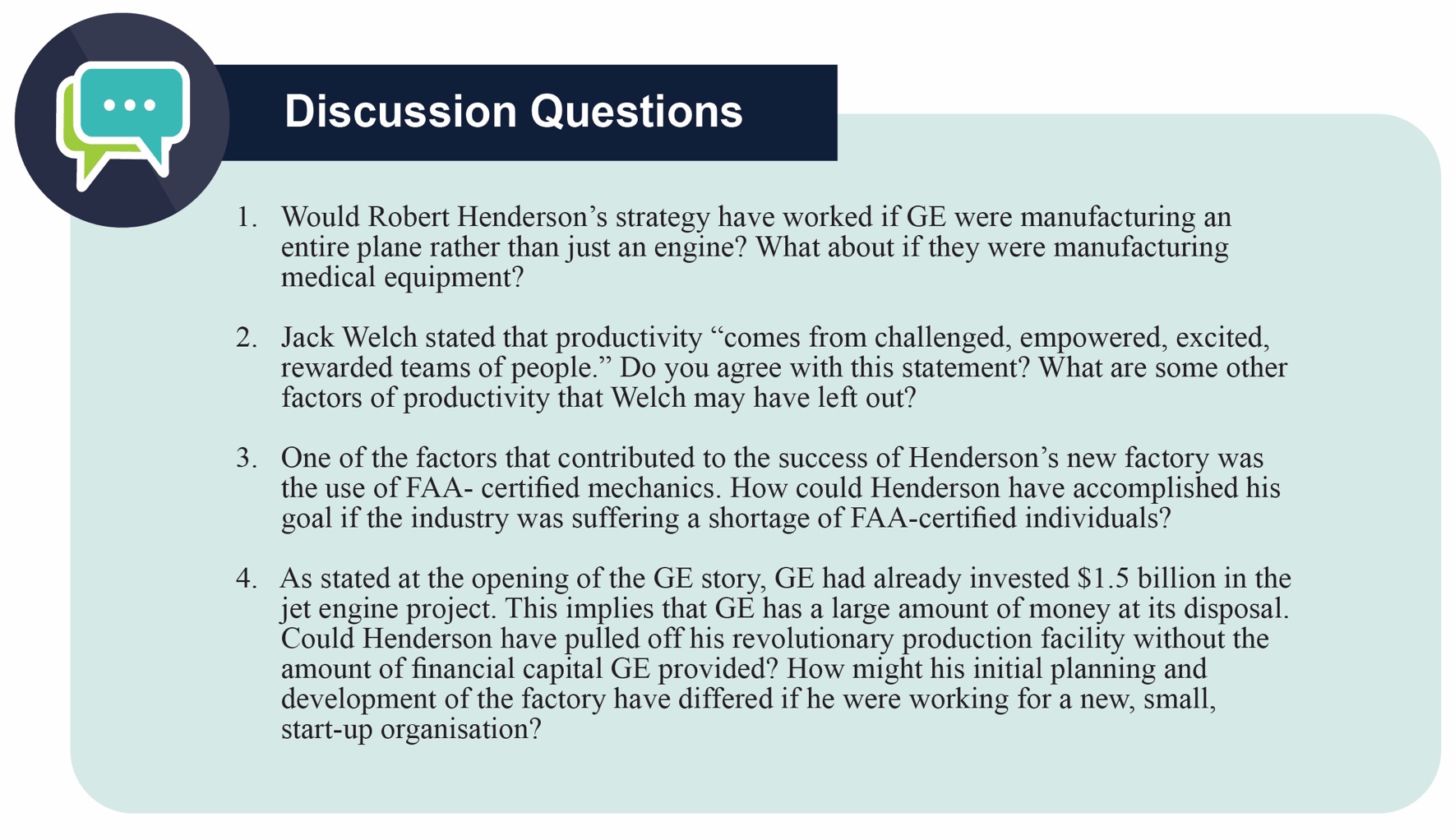Chapter 9: Managing Groups and Teams

Learning Objectives
After reading this chapter, you should be able to do the following:
- Recognize and understand group dynamics and development
- Understand the difference between groups and teams.
- Compare and contrast different types of teams.
- Understand how to design effective teams.
9.1 Teamwork Takes to the Sky: The Case of General Electric

In Durham, North Carolina, Robert Henderson was opening a factory for General Electric Company (NYSE: GE). The goal of the factory was to manufacture the largest commercial jet engine in the world. Henderson’s opportunity was great and so were his challenges. GE hadn’t designed a jet engine from the ground up for over 2 decades. Developing the jet engine project had already cost GE $1.5 billion. That was a huge sum of money to invest—and an unacceptable sum to lose should things go wrong in the manufacturing stage.
How could one person fulfill such a vital corporate mission? The answer, Henderson decided, was that one person couldn’t fulfill the mission. Even Jack Welch, GE’s CEO at the time, said, “We now know where productivity comes from. It comes from challenged, empowered, excited, rewarded teams of people.”
Empowering factory workers to contribute to GE’s success sounded great in theory. But how to accomplish these goals in real life was a more challenging question. Factory floors, traditionally, are unempowered work-places where workers are more like cogs in a vast machine than self-determining team members.
In the name of teamwork and profitability, Henderson travelled to other factories looking for places where worker autonomy was high. He implemented his favourite ideas at the factory in Durham. Instead of hiring generic “mechanics,” for example, Henderson hired staffers with FAA (Federal Aviation Administration) mechanic’s licenses. This superior training created a team capable of making vital decisions with minimal oversight, a fact that upped the factory’s output and his workers’ feelings of worth.
Henderson’s “self-managing” factory functioned beautifully. And it looked different too. Plant manager Jack Fish described Henderson’s radical factory, saying Henderson “didn’t want to see supervisors, he didn’t want to see forklifts running all over the place, he didn’t even want it to look traditional. There’s clutter in most plants, racks of parts and so on. He didn’t want that.”
Henderson also contracted out non-job-related chores, such as bathroom cleaning, that might have been assigned to workers in traditional factories. His insistence that his workers should contribute their highest talents to the team showed how much he valued them. And his team valued their jobs in turn.
Six years later, a Fast Company reporter visiting the plant noted, “GE/Durham team members take such pride in the engines they make that they routinely take brooms in hand to sweep out the beds of the 18-wheelers that transport those engines—just to make sure that no damage occurs in transit.” For his part, Henderson, who remained at GE beyond the project, noted, “I was just constantly amazed by what was accomplished there.”
GE’s bottom line showed the benefits of teamwork too. From the early 1980s, when Welch became CEO, until 2000, when he retired, GE generated more wealth than any organization in the history of the world (Fishman, 1999; Guttman, 2008; Lear, 1998).
9.2 Group Dynamics
What is a group? A group is a collection of individuals who interact with each other such that one person’s actions have an impact on the others. In organizations, most work is done within groups. How groups function has important implications for organizational productivity. Groups where people get along, feel the desire to contribute to the team, and are capable of coordinating their efforts may have high performance levels, whereas teams characterized by extreme levels of conflict or hostility may demoralize members of the workforce.
In organizations, you may encounter different types of groups. Informal work groups are made up of two or more individuals who are associated with one another in ways not prescribed by the formal organization. For example, a few people in the company who get together to play tennis on the weekend would be considered an informal group. A formal work group is made up of managers, subordinates, or both with close associations among group members that influence the behaviour of individuals in the group. We will discuss many different types of formal work groups later on in this chapter.
Stages of Group Development
Forming, Storming, Norming, and Performing
American organizational psychologist Bruce Tuckman presented a robust model in 1965 that is still widely used today. Based on his observations of group behaviour in a variety of settings, he proposed a four-stage map of group evolution, also known as the forming-storming-norming-performing model (Tuckman, 1965). Later he enhanced the model by adding a fifth and final stage, the adjourning phase. Interestingly enough, just as an individual moves through developmental stages such as childhood, adolescence, and adulthood, so does a group, although in a much shorter period of time. According to this theory, in order to successfully facilitate a group, the leader needs to move through various leadership styles over time.

Forming
In the forming stage, the group comes together for the first time. The members may already know each other or they may be total strangers. In either case, there is a level of formality, some anxiety, and a degree of guardedness as group members are not sure what is going to happen next. “Will I be accepted? What will my role be? Who has the power here?” These are some of the questions participants think about during this stage of group formation. Because of the large amount of uncertainty, members tend to be polite, conflict avoidant, and observant. They are trying to figure out the “rules of the game” without being too vulnerable. At this point, they may also be quite excited and optimistic about the task at hand, perhaps experiencing a level of pride at being chosen to join a particular group. Group members are trying to achieve several goals at this stage, although this may not necessarily be done consciously. First, they are trying to get to know each other. Often this can be accomplished by finding some common ground. Members also begin to explore group boundaries to determine what will be considered acceptable behaviour. “Can I interrupt? Can I leave when I feel like it?” This trial phase may also involve testing the appointed leader or seeing if a leader emerges from the group.
Storming
Once group members feel sufficiently safe and included, they tend to enter the storming phase. Participants focus less on keeping their guard up as they shed social facades, becoming more authentic and more argumentative. Group members begin to explore their power and influence, and they often stake out their territory by differentiating themselves from the other group members rather than seeking common ground. Discussions can become heated as participants raise contending points of view and values, or argue over how tasks should be done and who is assigned to them. It is not unusual for group members to become defensive, competitive, or jealous. They may even take sides or begin to form cliques within the group. Questioning and resisting direction from the leader is also quite common. “Why should I have to do this? Who designed this project in the first place? Why do I have to listen to you?” Although little seems to get accomplished at this stage, group members are becoming more authentic as they express their deeper thoughts and feelings. What they are really exploring is “Can I truly be me, have power, and be accepted?” During this chaotic stage, a great deal of creative energy that was previously buried is released and available for use, but it takes skill to move the group from storming to norming. In many cases, the group gets stuck in the storming phase. Once group members discover that they can be authentic and that the group is capable of handling differences without dissolving, they are ready to enter the next stage, norming.
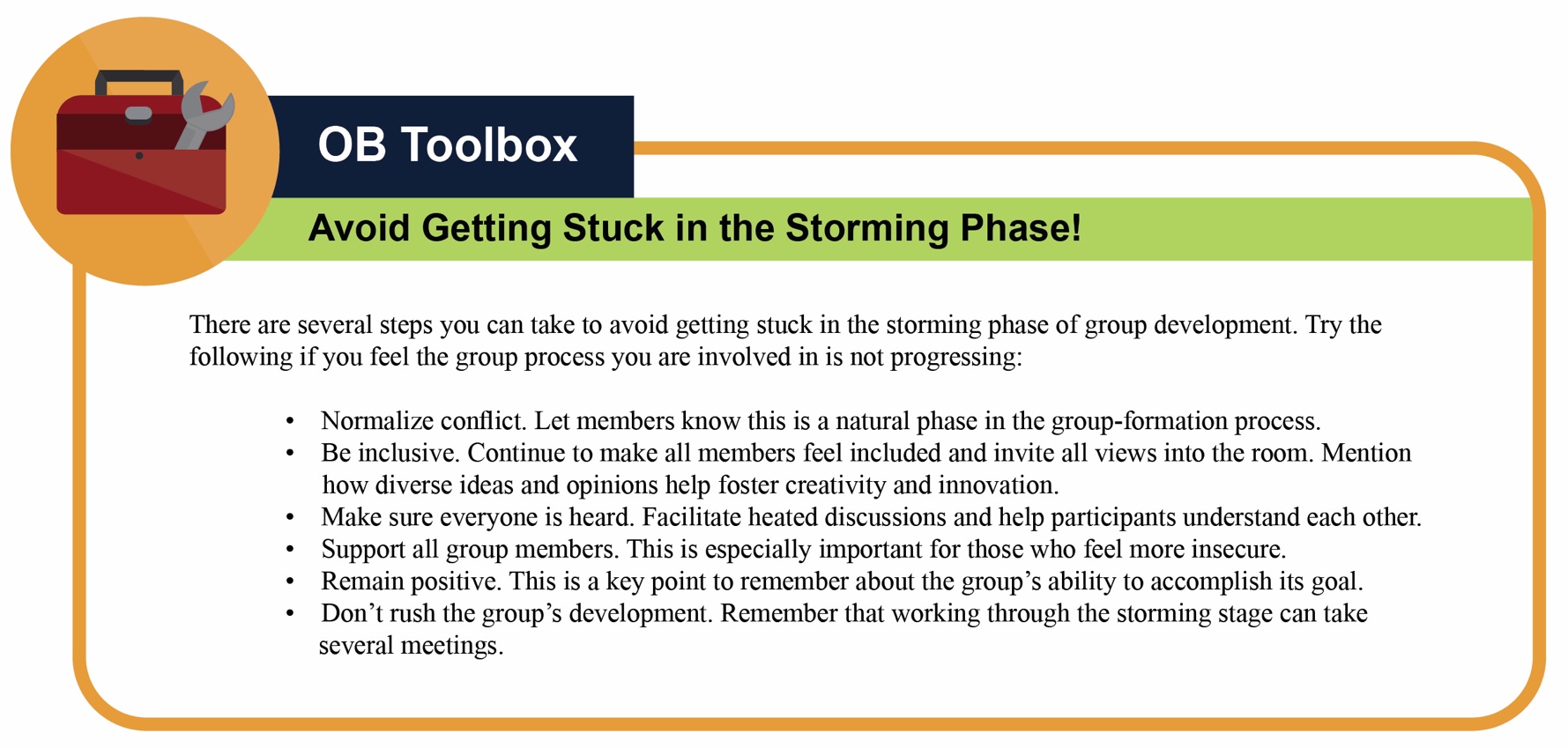
Norming
“We survived!” is the common sentiment at the norming stage. Group members often feel elated at this point, and they are much more committed to each other and the group’s goal. Feeling energized by knowing they can handle the “tough stuff,” group members are now ready to get to work. Finding themselves more cohesive and cooperative, participants find it easy to establish their own ground rules (or norms) and define their operating procedures and goals. The group tends to make big decisions, while subgroups or individuals handle the smaller decisions. Hopefully, at this point the group is more open and respectful toward each other, and members ask each other for both help and feedback.
Performing
Galvanized by a sense of shared vision and a feeling of unity, the group is ready to go into high gear. Members are more interdependent, individuality and differences are respected, and group members feel themselves while being part of a greater entity. At the performing stage, participants are not only getting the work done, but they also pay greater attention to how they are doing it. They ask questions like, “Do our operating procedures best support productivity and quality assurance? Do we have suitable means for addressing differences that arise so we can preempt destructive conflicts? Are we relating to and communicating with each other in ways that enhance group dynamics and help us achieve our goals? How can I further develop as a person to become more effective?”
Adjourning
Just as groups form, so do they end. For example, many groups or teams formed in a business context are project oriented and therefore are temporary in nature. Alternatively, a working group may dissolve due to an organizational restructuring. Just as when we graduate from school or leave home for the first time, these endings can be bittersweet, with group members feeling a combination of victory, grief, and, insecurity about what is coming next.
Social Loafing
Social loafing refers to the tendency of individuals to put in less effort when working in a group context. This phenomenon, also known as the Ringelmann effect, was first noted by French agricultural engineer Max Ringelmann in 1913. In one study, he had people pull on a rope individually and in groups. He found that as the number of people pulling increased, the group’s total pulling force was less than the individual efforts had been when measured alone (Karau & Williams, 1993).
Why do people work less hard when they are working with other people? Observations show that as the size of the group grows, this effect becomes larger as well (Karau & Williams, 1993). The social loafing tendency is less a matter of being lazy and more a matter of perceiving that one will receive neither one’s fair share of rewards if the group is successful nor blame if the group fails. Rationales for this behaviour include, “My own effort will have little effect on the outcome,” “Others aren’t pulling their weight, so why should I?” or “I don’t have much to contribute, but no one will notice anyway.” This is a consistent effect across a great number of group tasks and countries (Gabrenya, Latane, & Wang, 1983; Harkins & Petty, 1982; Taylor & Faust, 1952; Ziller, 1957). Research also shows that perceptions of fairness are related to levels of social loafing (Price, Harrison, & Gavin, 2006). Therefore, teams that are deemed as more fair should also see less social loafing.
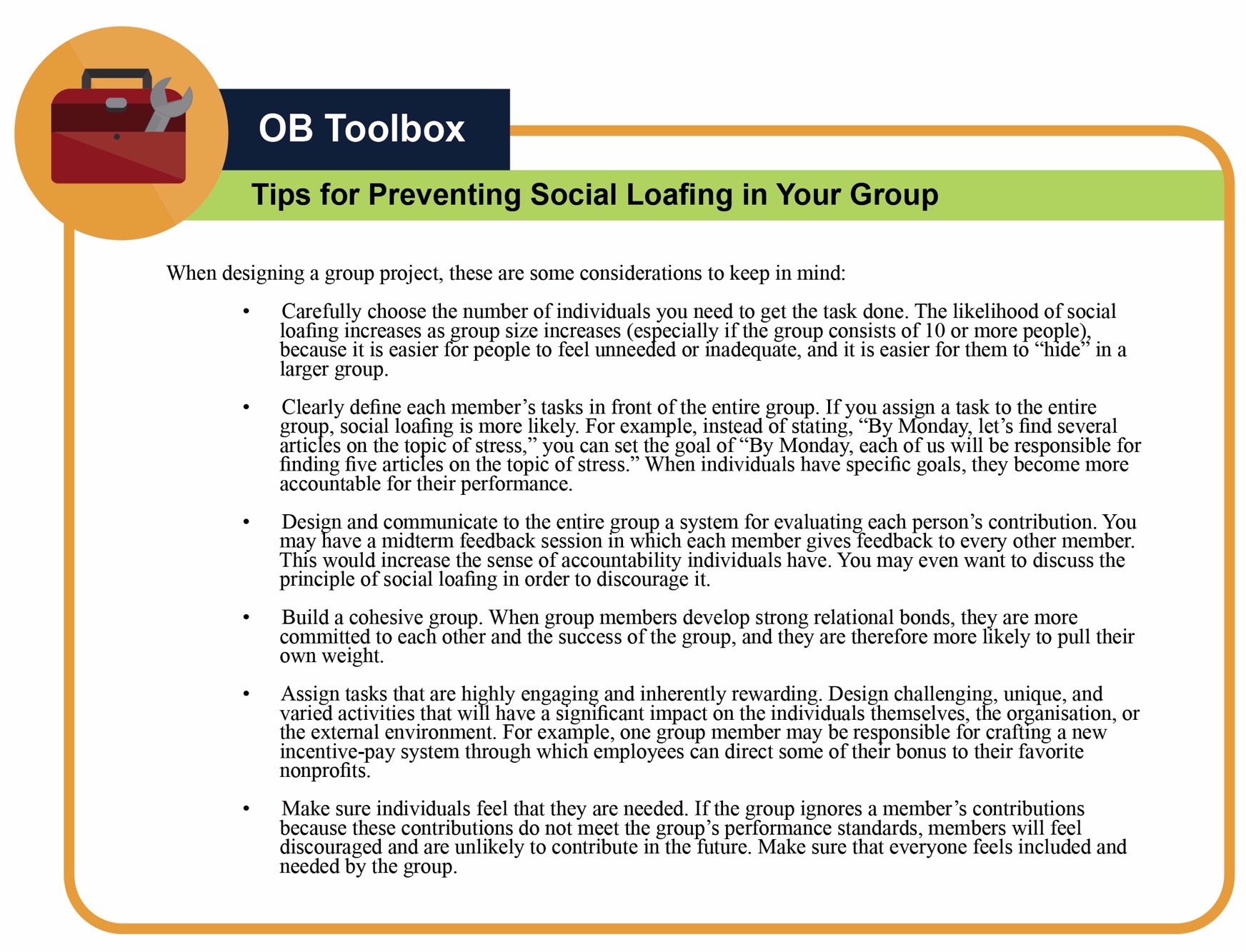
9.3 Understanding Team Design Characteristics
Effective teams give companies a significant competitive advantage. In a high-functioning team, the sum is truly greater than the parts. Team members not only benefit from each other’s diverse experiences and perspectives but also stimulate each other’s creativity. Plus, for many people, working in a team can be more fun than working alone.
Differences Between Groups and Teams
Organizations consist of groups of people. What exactly is the difference between a group and a team? A group is a collection of individuals. Within an organization, groups might consist of project-related groups such as a product group or division, or they can encompass an entire store or branch of a company. The performance of a group consists of the inputs of the group minus any process losses, such as the quality of a product, ramp-up time to production, or the sales for a given month. Process loss is any aspect of group interaction that inhibits group functioning.
Why do we say group instead of team? A collection of people is not a team, though they may learn to function in that way. A team is a cohesive coalition of people working together to achieve mutual goals. Being on a team does not equate to a total suppression of personal agendas, but it does require a commitment to the vision and involves each individual working toward accomplishing the team’s objective. Teams differ from other types of groups in that members are focused on a joint goal or product, such as a presentation, discussing a topic, writing a report, creating a new design or prototype, or winning a team Olympic medal. Moreover, teams also tend to be defined by their relatively smaller size. For example, according to one definition, “A team is a small number of people with complementary skills who are committed to a common purpose, performance goals, and approach for which they are mutually accountable” (Katzenbach & Smith, 1993).The key properties of a true team include collaborative action in which, along with a common goal, teams have collaborative tasks. Conversely, in a group, individuals are responsible only for their own area.
Team Roles
Robert Sutton points out that the success of U.S. Airways Flight 1549 to land with no fatalities when it crashed into the Hudson River in New York City is a good example of an effective work team (Sutton, 2009). For example, reports show that Captain Chesley Sullenberger took over flying from copilot Jeff Skiles, who had handled the takeoff, but had less experience in the Airbus (Caruso, 2009). This is consistent with the research findings that effective teams divide up tasks so the best people are in the best positions.
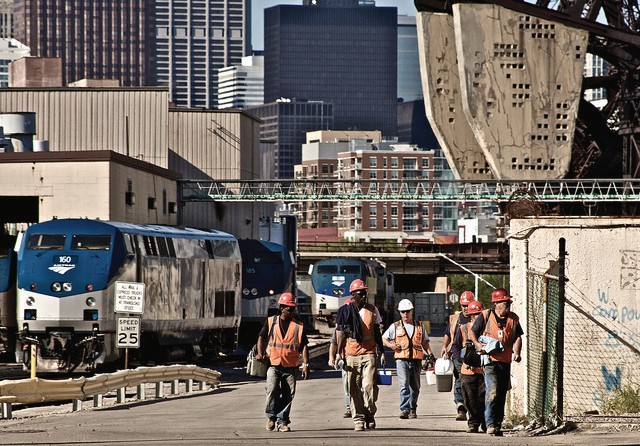
Studies show that individuals who are more aware of team roles and the behaviour required for each role perform better than individuals who do not. This fact remains true for both student project teams as well as work teams, even after accounting for intelligence and personality (Mumford et al., 2008). Early research found that teams tend to have two categories of roles consisting of those related to the tasks at hand and those related to the team’s functioning. For example, teams that focus only on production at all costs may be successful in the short run, but if they pay no attention to how team members feel about working 70 hours a week, they are likely to experience high turnover.
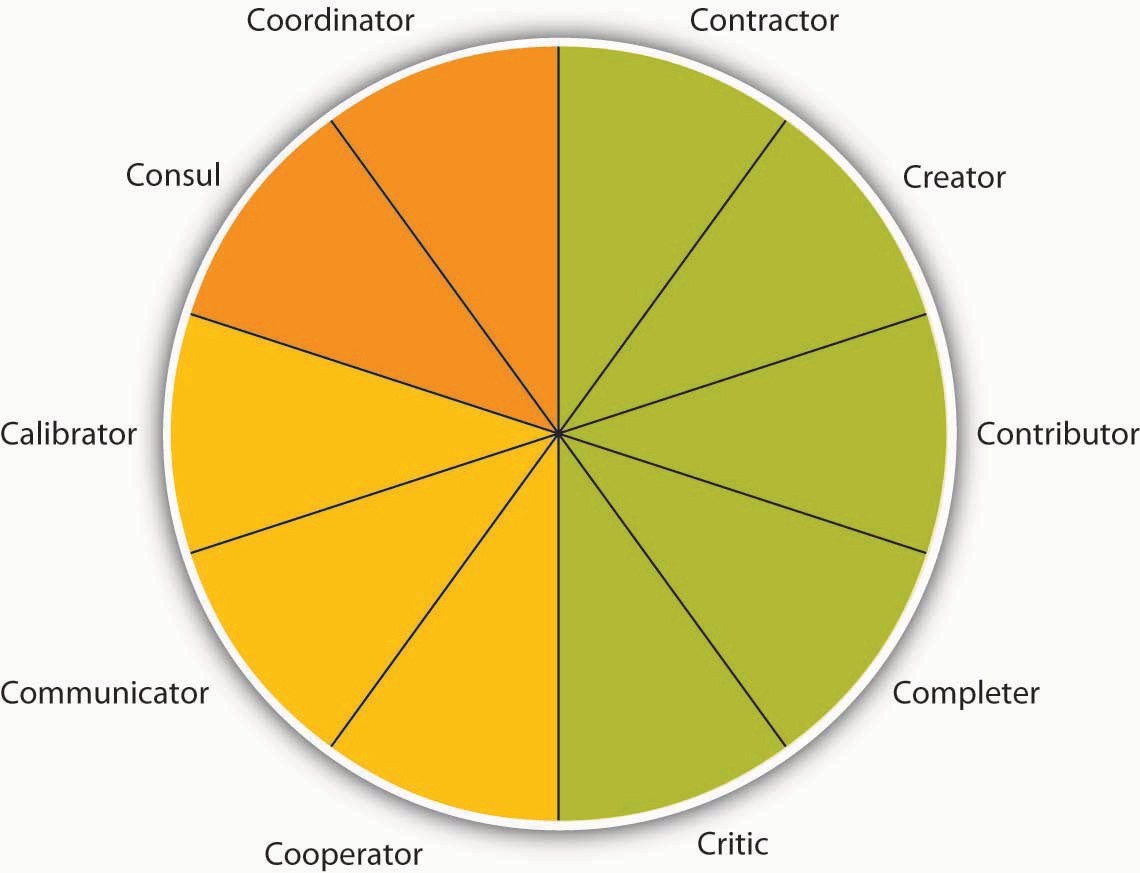
Based on decades of research on teams, 10 key roles have been identified (Bales, 1950; Benne & Sheats, 1948; Belbin, 1993). Team leadership is effective when leaders are able to adapt the roles they are contributing or asking others to contribute to fit what the team needs given its stage and the tasks at hand (Kozlowski et al., 1996; Kozlowski et al., 1996). Ineffective leaders might always engage in the same task role behaviours, when what they really need is to focus on social roles, put disagreements aside, and get back to work. While these behaviours can be effective from time to time, if the team doesn’t modify its role behaviours as things change, they most likely will not be effective.
Task Roles
Five roles make up the task portion of the typology. The contractor role includes behaviours that serve to organize the team’s work, including creating team timelines, production schedules, and task sequencing. The creator role deals more with changes in the team’s task process structure. For example, reframing the team goals and looking at the context of goals would fall under this role. The contributor role is important, because it brings information and expertise to the team. This role is characterized by sharing knowledge and training with those who have less expertise to strengthen the team. Research shows that teams with highly intelligent members and evenly distributed workloads are more effective than those with uneven workloads (Ellis et al., 2003). The completer role is also important, as it transforms ideas into action. Behaviours associated with this role include following up on tasks, such as gathering needed background information or summarizing the team’s ideas into reports. Finally, the critic role includes “devil’s advocate” behaviours that go against the assumptions being made by the team.
Social Roles
Social roles serve to keep the team operating effectively. When the social roles are filled, team members feel more cohesive, and the group is less prone to suffer process losses or biases such as social loafing, groupthink, or a lack of participation from all members. Three roles fall under the umbrella of social roles. The cooperator role includes supporting those with expertise toward the team’s goals. This is a proactive role. The communicator role includes behaviours that are targeted at collaboration, such as practicing good listening skills and appropriately using humor to diffuse tense situations. Having a good communicator helps the team to feel more open to sharing ideas. The calibrator role is an important one that serves to keep the team on track in terms of suggesting any needed changes to the team’s process. This role includes initiating discussions about potential team problems such as power struggles or other tensions. Similarly, this role may involve settling disagreements or pointing out what is working and what is not in terms of team process.
Boundary-Spanning Roles
The final two goals are related to activities outside the team that help to connect the team to the larger organization (Anacona, 1990; Anacona, 1992; Druskat & Wheeler, 2003). Teams that engage in a greater level of boundary-spanning behaviours increase their team effectiveness (Marrone, Tesluk, & Carson, 2007). The consul role includes gathering information from the larger organization and informing those within the organization about team activities, goals, and successes. Often the consul role is filled by team managers or leaders. The coordinator role includes interfacing with others within the organization so that the team’s efforts are in line with other individuals and teams within the organization.
Team Leadership and Autonomy
Teams also vary in terms of how they are led. Traditional manager-led teams are teams in which the manager serves as the team leader. The manager assigns work to other team members. These types of teams are the most natural to form, with managers having the power to hire and fire team members and being held accountable for the team’s results.
Self-managed teams are a new form of team that rose in popularity with the Total Quality Movement in the 1980s. Unlike manager-led teams, these teams manage themselves and do not report directly to a supervisor. Instead, team members select their own leader, and they may even take turns in the leadership role. Self-managed teams also have the power to select new team members. As a whole, the team shares responsibility for a significant task, such as assembly of an entire car. The task is ongoing rather than a temporary task such as a charity fund drive for a given year.
Self-managed teams are empowered teams, which means that they have the responsibility as well as the authority to achieve their goals. Team members have the power to control tasks and processes and to make decisions. Research shows that self-managed teams may be at a higher risk of suffering from negative outcomes due to conflict, so it is important that they are supported with training to help them deal with conflict effectively (Alper, Tjosvold, & Law, 2000; Langfred, 2007). Self-managed teams may still have a leader who helps them coordinate with the larger organization (Morgeson, 2005).

Designing Effective Teams
Designing an effective team means making decisions about team composition (who should be on the team), team size (the optimal number of people on the team), and team diversity (should team members be of similar background, such as all engineers, or of different backgrounds). Answering these questions will depend, to a large extent, on the type of task that the team will be performing. Teams can be charged with a variety of tasks, from problem solving to generating creative and innovative ideas to managing the daily operations of a manufacturing plant.
Who Are the Best Individuals for the Team?
A key consideration when forming a team is to ensure that all the team members are qualified for the roles they will fill for the team. This process often entails understanding the knowledge, skills, and abilities (KSAs) of team members as well as the personality traits needed before starting the selection process (Humphrey et al., 2007). When talking to potential team members, be sure to communicate the job requirements and norms of the team. Think of ways to train the team members as much as possible to help ensure success and cohesiveness. In addition to task knowledge, research has shown that individuals who understand the concepts covered in this chapter and in this book, such as conflict resolution, motivation, planning, and leadership, actually perform better on their jobs. This finding holds for a variety of jobs, including being an officer in the U.S. Air Force, an employee at a pulp mill, or a team member at a box manufacturing plant (Hirschfeld et al., 2006; Stevens & Campion, 1999).
How Large Should My Team Be?
Interestingly, research has shown that regardless of team size, the most active team member speaks 43% of the time. The difference is that the team member who participates the least in a 3-person team is still active 23% of the time versus only 3% in a 10-person team (McGrath, 1984; Solomon, 1960). When deciding team size, a good rule of thumb is a size of two to 20 members.
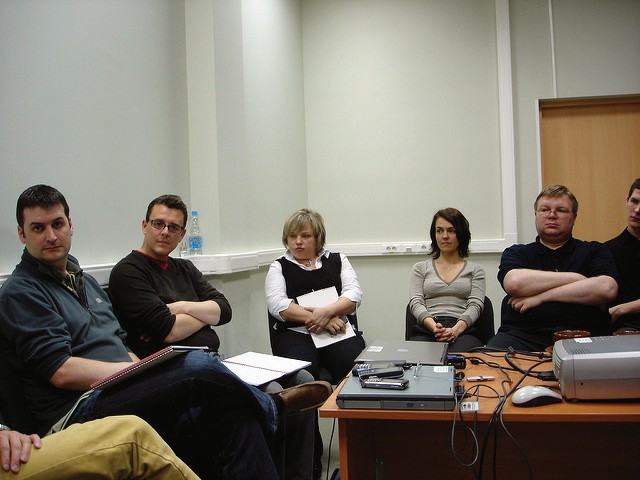
Research shows that groups with more than 20 members have less cooperation (Gratton & Erickson, 2007). The majority of teams have 10 members or less, because the larger the team, the harder it is to coordinate and interact as a team. With fewer individuals, team members are more able to work through differences and agree on a common plan of action. They have a clearer understanding of others’ roles and greater accountability to fulfill their roles, limiting social loafing. Some tasks, however, require larger team sizes because of the need for diverse skills or because of the complexity of the task. In those cases, the best solution is to create sub-teams in which one member from each sub-team is a member of a larger coordinating team. The relationship between team size and performance seems to greatly depend on the level of task interdependence, with some studies finding larger teams outproducing smaller teams and other studies finding just the opposite (Campion, Medsker, & Higgs, 1993; Magjuka & Baldwin, 1991; Vinokur-Kaplan, 1995). The bottom line is that team size should be matched to the goals of the team.
How Diverse Should My Team Be?
Team composition and team diversity often go hand in hand. Teams whose members have complementary skills are often more successful because members can see each other’s blind spots. One team member’s strengths can compensate for another’s weaknesses (Jackson, Joshi, & Erhardt, 2003; van Knippenberg, De Dreu, & Homan, 2004). For example, consider the challenge that companies face when trying to forecast future sales of a given product. Workers who are educated as forecasters have the analytic skills needed for forecasting, but these workers often lack critical information about customers. Salespeople, in contrast, regularly communicate with customers, which means they’re in the know about upcoming customer decisions. But salespeople often lack the analytic skills, discipline, or desire to enter this knowledge into spreadsheets and software that will help a company forecast future sales. Putting forecasters and salespeople together on a team tasked with determining the most accurate product forecast each quarter makes the best use of each member’s skills and expertise.
Diversity in team composition can help teams come up with more creative and effective solutions. Research shows that teams that believe in the value of diversity performed better than teams that do not (Homan et al., 2007). The more diverse a team is in terms of expertise, gender, age, and background, the more ability the group has to avoid the problems of groupthink (Surowiecki, 2005). For example, different educational levels for team members were related to more creativity in R&D teams and faster time to market for new products (Eisenhardt & Tabrizi, 1995; Shin & Zhou, 2007). Members will be more inclined to make different kinds of mistakes, which means that they’ll be able to catch and correct those mistakes.
9.4 Management of Teams
Establishing Team Norms
Team Norms
Norms are shared expectations about how things operate within a group or team. Just as new employees learn to understand and share the assumptions, norms, and values that are part of an organization’s culture, they also must learn the norms of their immediate team. This understanding helps teams be more cohesive and perform better. Norms are a powerful way of ensuring coordination within a team. For example, is it acceptable to be late to meetings? How prepared are you supposed to be at the meetings? Is it acceptable to criticize someone else’s work? These norms are shaped early during the life of a team and affect whether the team is productive, cohesive, and successful.
Team Contracts
Scientific research, as well as experience working with thousands of teams, show that teams that are able to articulate and agree on established ground rules, goals, and roles and develop a team contract around these standards are better equipped to face challenges that may arise within the team (Katzenback & Smith, 1993; Porter & Lilly, 1996). Having a team contract does not necessarily mean that the team will be successful, but it can serve as a road map when the team veers off course. The following questions can help to create a meaningful team contract:
- Team Values and Goals
- What are our shared team values?
- What is our team goal?
- Team Roles and Leadership
- Who does what within this team? (Who takes notes at the meeting? Who sets the agenda? Who assigns tasks? Who runs the meetings?)
- Does the team have a formal leader?
- If so, what are his or her roles?
- Team Decision Making
- How are minor decisions made?
- How are major decisions made?
- Team Communication
- Who do you contact if you cannot make a meeting?
- Who communicates with whom?
- How often will the team meet?
- Team Performance
- What constitutes good team performance?
- What if a team member tries hard but does not seem to be producing quality work?
- How will poor attendance/work quality be dealt with?
Team Meetings
Anyone who has been involved in a team knows it involves team meetings. While few individuals relish the idea of team meetings, they serve an important function in terms of information sharing and decision making. They also serve an important social function and can help to build team cohesion and a task function in terms of coordination. Unfortunately, we’ve all attended meetings that were a waste of time and little happened that couldn’t have been accomplished by reading an e-mail in 5 minutes. To run effective meetings, it helps to think of meetings in terms of three sequential steps (Haynes, 1997).
Before the Meeting
Much of the effectiveness of a meeting is determined before the team gathers. There are three key things you can do to ensure the team members get the most out of their meeting.
Is a meeting needed? Leaders should do a number of things prior to the meeting to help make it effective. The first thing is to be sure a meeting is even needed. If the meeting is primarily informational in nature, ask yourself if it is imperative that the group fully understands the information and if future decisions will be built upon this information. If so, a meeting may be needed. If not, perhaps simply communicating with everyone in a written format will save valuable time. Similarly, decision-making meetings make the most sense when the problem is complex and important, there are questions of fairness to be resolved, and commitment is needed moving forward.
Create and distribute an agenda. An agenda is important in helping to inform those invited about the purpose of the meeting. It also helps organize the flow of the meeting and keep the team on track.
Send a reminder prior to the meeting. Reminding everyone of the purpose, time, and location of the meeting helps everyone prepare themselves. Anyone who has attended a team meeting only to find there is no reason to meet because members haven’t completed their agreed-upon tasks knows that, as a result, team performance or morale can be negatively impacted. Follow up to make sure everyone is prepared. As a team member, inform others immediately if you will not be ready with your tasks so that they can determine whether the meeting should be postponed.
During the Meeting
During the meeting there are several things you can do to make sure the team starts and keeps on track.
Start the meeting on time. Waiting for members who are running late only punishes those who are on time and reinforces the idea that it’s OK to be late. Starting the meeting promptly sends an important signal that you are respectful of everyone’s time.
Follow the meeting agenda. Veering off agenda communicates to members that the agenda is not important. It also makes it difficult for others to keep track of where you are in the meeting.
Manage group dynamics for full participation. As you’ve seen in this chapter, a number of group dynamics can limit a team’s functioning. Be on the lookout for full participation and engagement from all team members, as well as any potential problems such as social loafing, group conflict, or groupthink.
Summarize the meeting with action items. Be sure to clarify team member roles moving forward. If individuals’ tasks are not clear, chances are that role confusion will arise later. There should be clear notes from the meeting regarding who is responsible for each action item and the time frames associated with next steps.
End the meeting on time. This is vitally important, as it shows that you respect everyone’s time and are organized. If another meeting is needed to follow up, schedule it later, but don’t let the meeting run over.
After the Meeting
Follow up on action items. During the meeting, participants probably generated several action items. It is likely that you’ll need to follow up on the action items of others.

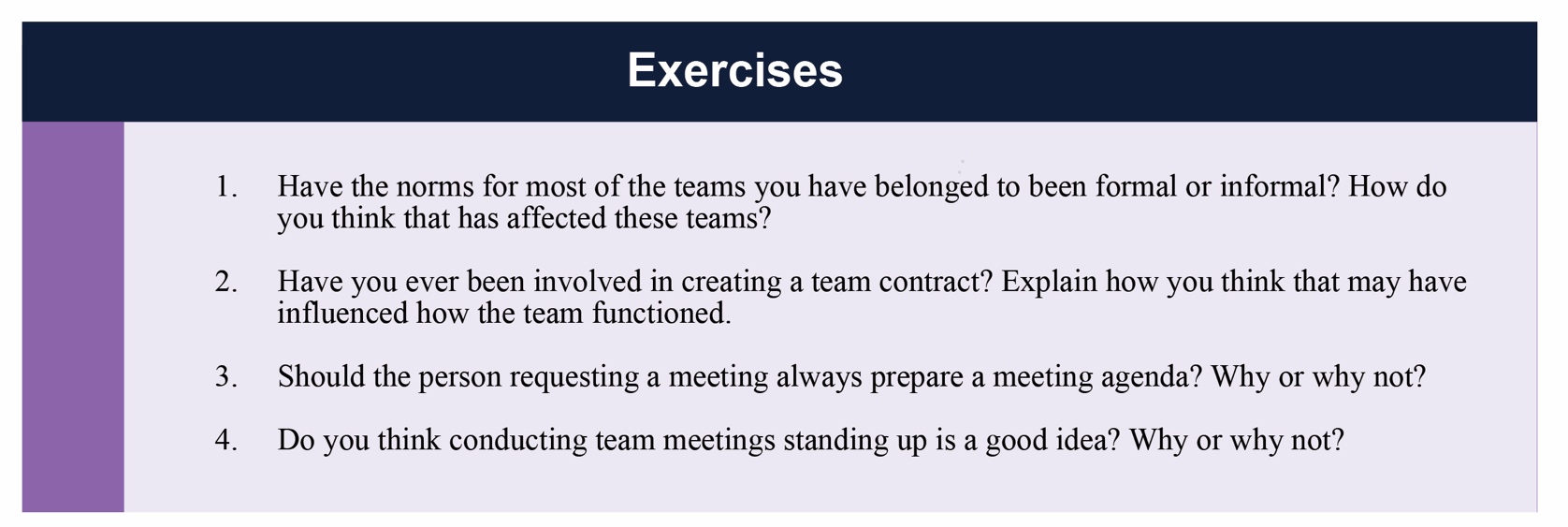
9.5 Barriers to Effective Teams
Problems can arise in any team that will hurt the team’s effectiveness. Here are some common problems faced by teams and how to deal with them.
Common Problems Faced by Teams
Challenges of Knowing Where to Begin
At the start of a project, team members may be at a loss as to how to begin. Also, they may have reached the end of a task but are unable to move on to the next step or put the task to rest. Floundering often results from a lack of clear goals, so the remedy is to go back to the team’s mission or plan and make sure that it is clear to everyone. Team leaders can help move the team past floundering by asking, “What is holding us up? Do we need more data? Do we need assurances or support? Does anyone feel that we’ve missed something important?”
Dominating Team Members
Some team members may have a dominating personality that encroaches on the participation or air time of others. This overbearing behaviour may hurt the team morale or the momentum of the team. A good way to overcome this barrier is to design a team evaluation to include a “balance of participation” in meetings. Knowing that fair and equitable participation by all will affect the team’s performance evaluation will help team members limit domination by one member and encourage participation from all members, even shy or reluctant ones. Team members can say, “We’ve heard from Mary on this issue, so let’s hear from others about their ideas.”
Poor Performance of Team Members
Research shows that teams deal with poor performers in different ways, depending on members’ perceptions of the reasons for poor performance (Jackson & LePine, 2003). In situations in which the poor performer is perceived as lacking in ability, teams are more likely to train the member. When members perceive the individual as simply being low on motivation, they are more likely to try to motivate or reject the poor performer. Keep in mind that justice is an important part of keeping individuals working hard for the team (Colquitt, 2004). Be sure that poor performers are dealt with in a way that is deemed fair by all the team members.
Poorly Managed Team Conflict
Disagreements among team members are normal and should be expected. Healthy teams raise issues and discuss differing points of view, because that will ultimately help the team reach stronger, more well-reasoned decisions. Unfortunately, sometimes disagreements arise owing to personality issues or feuds that predated a team’s formation. Ideally, teams should be designed to avoid bringing adversaries together on the same team. If that is not possible, the next best solution is to have adversaries discuss their issues privately, so the team’s progress is not disrupted. The team leader or other team member can offer to facilitate the discussion. One way to make a discussion between conflicting parties meaningful is to form a behavioural contract between the two parties. That is, if one party agrees to do X, then the other will agree to do Y (Scholtes, 1988).


9.6 Mini Case Scenario
ONE FOR ALL
HOW TO PREVENT CO-WORKERS FROM LETTING YOU DOWN
You are enrolled in an undergraduate business course that requires that you participate in a group project. Not wanting to be scrambling at the last moment, you quickly sign up with a group and create a group chat for the whole team. This will help you to get organized so that things will not be left to the last minute.
A couple of weeks before the project is due, assignments are sorted among the group members. You decide that, because your mark in this course is very important to your overall GPA, you will do the final edit of the whole assignment and fine-tune it for any mistakes. To give yourself ample time to do this you explain to the group that you want everyone’s part five days before the submission date.
Despite your request, no one sends you their part of the work on time. You message the chat to see what is going on. Some people don’t reply; others say they have been busy but are finishing up; and some say they haven’t started. You start to get worried but understand that ‘life happens,’ so you suggest they send it to you three days before the deadline.
T-minus three days and no one has completed their part of the project. You again message and receive the same response as before. You are now very worried, and by the next day you still have received only two submissions, which you edit.
The next day you finish work at 9 p.m., hoping that the rest of the group members have sent their parts, considering the submission deadline is tomorrow. Realizing you have not received any more submissions, you message the chat to see what is going on but get no response. Knowing that your marks are on the line you start doing the project yourself. You stay up all night to single-handedly finish what was supposed to be done by four people. The next morning you go to school and hand in the completed paper.
You are furious with your group. What do you do now? What are your options? How might you have managed this differently? Why?
Hilary Martin and Nayaab Bajwa © Ted Rogers Leadership Centre. This case is made available for public use under a Creative Commons Attribution-Non Commercial-No Derivs (CC BY-NC-ND) license.
9.6 (b) Green Teams at Work: The Case of New Seasons Market
Teamwork is important at New Seasons Market Inc. (a privately held company). This is a relatively small chain of upscale grocery stores in the Pacific Northwest that are built on the ideas of local identity, quality products, and employee freedom to meet the needs of customers. Formed in 1999 by a group of people with similar goals, New Seasons Market operates nine grocery stores in various Portland area neighborhoods. Though the look and products of the stores are consistent, each store is predominantly staffed by individuals that live in the local neighborhood, enabling each store to know the needs of its customers and create an internal identity all its own.

One of the ways each store creates that identity is through Green Teams. These teams are typically composed of up to 13 paid employees from various departments. Teams join together to address social and environmental issues of sustainability within each store and its surrounding community. The idea for Green Teams originated from a group of employees in one store that assembled to tackle “green” issues in their store. Corporate managers (who also have their own Green Team) agreed that it was such a good idea that now every store is required to have a Green Team. Each team meets monthly and reports to the company sustainability coordinator. Team leadership structures vary from store to store, with some Green Teams having a single chairperson who serves the team for more than 1 year, while other teams regularly rotate leaders or even elect two cochairs to lead the cause. Teams act as liaisons between their department and the Green Team, help educate staff, and make recommendations to management. Store Green Teams also initiate community service projects and help maintain the waste diversion program.
Through this flexibility, each Green Team has accomplished a variety of projects in their store and local community, including wilderness and wetland cleanup, painting and weeding at a local elementary school, and helping plant gardens for low-income families. One suburban store even developed an intricate car pool program for employees to encourage a reduction in drive-alone car trips. As long as the Green Team’s focus is on their local store and community, they are granted freedom and support from corporate management. Safety and Sustainability Manager Heather Schmidt explains, “If there were too many rules, it could hold back creativity and passion. Having a balance is the key.”
Participation in Green Team initiatives has developed a friendly competition between stores and rewards for employees who participate. For example, every time an employee joins in the staff car pool, his or her name is entered into a monthly drawing for a gift card. These values of support and encouragement are consistent throughout New Seasons company culture, where employees are valued for their personal contributions. As their website explains, “To be a truly great company means that we continually evolve to meet the changing needs of our customers, our staff and the world around us.” With these values, New Seasons Market has created “a workplace that truly believes that taking good care of our co-workers, our customers, and our environment is what drives the success of our business” (Schmidt, 2010; Private company information: New Seasons Market Inc., 2010).
9.7 The Impact of Work-From-Home on Teamwork
For millions of Canadians, 2020 brought a sudden transition to working from home. Many organizations adopted a permanent transition to home, including the Ottawa-based e-commerce firm Shopify where over 5,000 of its employees transitioned to working from home. Work-from-home creates a unique set of dynamics when it comes to the influence on teamwork. In an interview-based study with 53 information workers from 17 U.S. teams, Breideband et al. (2022) found that long periods of remote work highlighted diversity in team members’ home lives. For example, some people have children while others don’t; some people live alone, while others are with partners, some have pets and others don’t, and some have large houses while others have small houses; some have more reliable internet than others, etc. These types of differences played minimal roles for teams in the office, but they had a more significant impact in the work-from-home setting. Specifically, there were more issues related to coordination delays and interruptions to conflicts related to workload fairness,
miscommunication, and trust. Workers reported that their teams adapted to these challenges by setting explicit norms and standards for online communication and asynchronous collaboration.
In similar research, Buła, Klecha, and Żak (2022) studied the impact of working from home on teamwork by surveying a geographically dispersed team of experts in a global corporation. They found that “despite numerous difficulties, what proved essential to the surveyed team’s successful functioning within the remote work context, were supportive leadership, teamwork, goodcommunication among the team members, and empathic and personalized interactions between the manager and the team members.” (p.2)
9.8 Supporting Neurodiverse Individuals with Teamwork
Keith’s research and experience have found that establishing patterns, defining success, and having daily patterns are among the six practices that are most beneficial to helping neurodiverse individuals be set up for success in organizational teamwork. Specifically, he calls to action the following six principles that aid neurodivergent teams:
- Establish patterns: Plan and execute work in iterations of a consistent duration, for instance, two weeks; ensure the collaborative team events within each iteration follow the same pattern and occur on the same days.
- Define success clearly: Describe each work item in a way that satisfies the team’s needs, giving particular attention to defining how the team will know when an item is acceptable and do
- Create transparency: Make the backlog of work items visible, empower the team to determine how they will do the work, and hold them accountable to decide on how much of the backlog they will achieve within the iteration.
- Meet daily: A brief standing meeting held simultaneously and place each day increases communication and allows the team to assess progress and adapt plans as needed.
- Inspect and adapt: Incorporate continuous improvement by retrospecting as a team on a previous iteration’s successes and struggles, and plan an experiment that could improve things during the subsequent one.
- Build bonds: Be intentional about connecting and developing as a team; encourage trusting relationships to create and persist; changes to team makeup should be rare.
9.9 Conclusion
Research shows that group formation is a beneficial but highly dynamic process. The life cycle of teams can often closely resemble various stages in individual development. In order to maintain group effectiveness, individuals should be aware of key stages as well as methods to avoid becoming stuck along the way. Good leadership skills combined with knowledge of group development will help any group perform at its peak level. Teams, though similar, are different from groups in both scope and composition. Groups are often small collections of individuals with various skill sets that combine to address a specific issue, whereas teams can be much larger and often consist of people with overlapping abilities working toward a common goal.
Many issues that can plague groups can also hinder the efficacy of a team. Problems such as social loafing or groupthink can be avoided by paying careful attention to team member differences and providing clear definitions for roles, expectancy, measurement, and rewards. Because many tasks in today’s world have become so complex, groups and teams have become an essential component of an organization’s success. The success of the team/group rests within the successful management of its members and making sure all aspects of work are fair for each member.
9.9 Exercises


